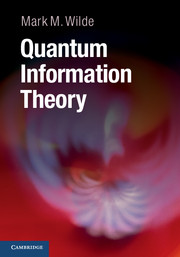Book contents
- Frontmatter
- Contents
- How To Use This Book
- Acknowledgments
- Part I Introduction
- Part II The Quantum Theory
- Part III Unit Quantum Protocols
- Part IV Tools of Quantum Shannon Theory
- Part V Noiseless Quantum Shannon Theory
- Part VI Noisy Quantum Shannon Theory
- 19 Classical Communication
- 20 Entanglement-Assisted Classical Communication
- 21 Coherent Communication with Noisy Resources
- 22 Private Classical Communication
- 23 Quantum Communication
- 24 Trading Resources for Communication
- 25 Summary and Outlook
- Appendix A Miscellaneous Mathematics
- Appendix B Monotonicity of Quantum Relative Entropy
- References
- Index
19 - Classical Communication
from Part VI - Noisy Quantum Shannon Theory
Published online by Cambridge University Press: 05 May 2013
- Frontmatter
- Contents
- How To Use This Book
- Acknowledgments
- Part I Introduction
- Part II The Quantum Theory
- Part III Unit Quantum Protocols
- Part IV Tools of Quantum Shannon Theory
- Part V Noiseless Quantum Shannon Theory
- Part VI Noisy Quantum Shannon Theory
- 19 Classical Communication
- 20 Entanglement-Assisted Classical Communication
- 21 Coherent Communication with Noisy Resources
- 22 Private Classical Communication
- 23 Quantum Communication
- 24 Trading Resources for Communication
- 25 Summary and Outlook
- Appendix A Miscellaneous Mathematics
- Appendix B Monotonicity of Quantum Relative Entropy
- References
- Index
Summary
This chapter begins our exploration of “dynamic” information-processing tasks in quantum Shannon theory, where the term “dynamic” indicates that a quantum channel connects a sender to a receiver and their goal is to exploit this resource for communication. We specifically consider the scenario where a sender Alice would like to communicate classical information to a receiver Bob, and the capacity theorem that we prove here is one particular generalization of Shannon's noisy channel coding theorem from classical information theory (overviewed in Section 2.2). In later chapters, we will see other generalizations of Shannon's theorem, depending on what resources are available to assist their communication or depending on whether they are trying to communicate classical or quantum information. For this reason and others, quantum Shannon theory is quite a bit richer than classical information theory.
The naive approach to communicate classical information over a quantum channel is for Alice and Bob simply to mimic the approach used in Shannon's noisy channel coding theorem. That is, they select a random classical code according to some distribution pX(x), and Bob performs individual measurements of the outputs of a noisy quantum channel according to some POVM. The POVM at the output induces some conditional probability distribution pY∣X(y∣x), which we can in turn think of as an induced noisy classical channel. The classical mutual information I(X; Y) of this channel is an achievable rate for communication, and the best strategy for Alice and Bob is to optimize the mutual information over all of Alice's inputs to the channel and over all measurements that Bob could perform at the output.
Information
- Type
- Chapter
- Information
- Quantum Information Theory , pp. 451 - 476Publisher: Cambridge University PressPrint publication year: 2013
